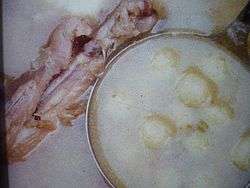Vori vori
 Chicken vorí vorí | |
| Type | Soup |
|---|---|
| Place of origin | Paraguay |
| Main ingredients | Corn flour, cheese, stock or broth |
Vorí vorí is a thick, yellow soup with little balls made of cornmeal, corn flour, and cheese.
As every dish of the Paraguayan popular gastronomy, the vorí vorí is rich in proteins and calories, fact that has historical reason, proven fully and scientifically.
Origin of the name
The name "vorí vorí" comes from the Guarani language, one of the two official languages of Paraguay. In Guarani, one way of specifying abundance is by repetition of a word. So, "vorí" is one, but "vorí vorí" can be two or more.
The word "vorí", which names the dish is a derivation of the Spanish word "bolita" ("little ball", in allusion to the little corn balls found in the dish). The word passed into Guarani as "borita", (no 'l' in Guarani) and finally shortened to "vorí". Then, "vorí vorí" is "bolita bolita".
Vori vori is traditionally served during the cold winter months, to keep people warm; although it is eaten occasionally during the summer.
Ingredients
To make a typical vorí vorí one needs: corn flour, fresh cheese, fatty soup or broth and, of course, water.
There are other variants generally denominated "vorí vorí blanco" with additional ingredients such as oil, garlic, onion, pumpkin, milk and rice.
Preparation
The corn flour and the crumbled cheese are put in a container, moistening this mixture with the fat broth until one has a mixture from which the little balls can easily be made by hand.
Every vorí should be the size of a big grape. Once there's enough little balls made, these are put in boiling soup and cooked for about 5 minutes. If the soup turns too thick, it can be thinned by adding more boiling water.
Interesting facts
The traditional vorí vorí is also known as "vorí vorí caldo".
- One of the most widespread recipes is the "vorí vorí de gallina", in which pieces of chicken previously grilled on its own fat are added to the soup.
- When the little balls are too small they're called "tu'i rupi'a" (the Guarani phrase for "parakeet eggs").
- The vorí vorí is one of the few Paraguayan dishes that is eaten among every social layer. It's consumed also in fancy banquets as in the humble tables of rustic ranches.
- According to some scholars of social history of Paraguay, all the Paraguayan popular gastronomy, which establishes itself as a small family industry after the Paraguayan War against The Triple Alliance (Argentina, Brazil and Uruguay, between 1864 and 1870), is really abundant in caloric content, because of the situation that overcame to the country after the conflict. In the aftermath of the war, food was limited, groceries were hard to find. So Paraguayan cooking has a high protein content to make up for the scarcity of every day meal.
References
- “Tembi’u Paraguay” JOSEFINA VELILLA DE AQUINO
- “Karú rekó – Antropología culinaria paraguaya”, MARGARITA MIRÓ IBARS
- "Guarani Fusion" Food Blog www.guaranifusion.com